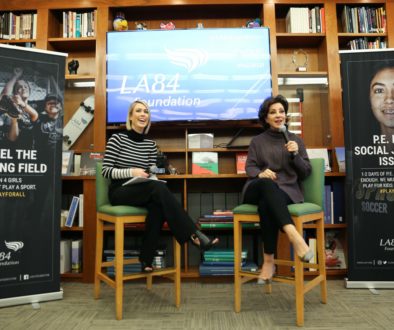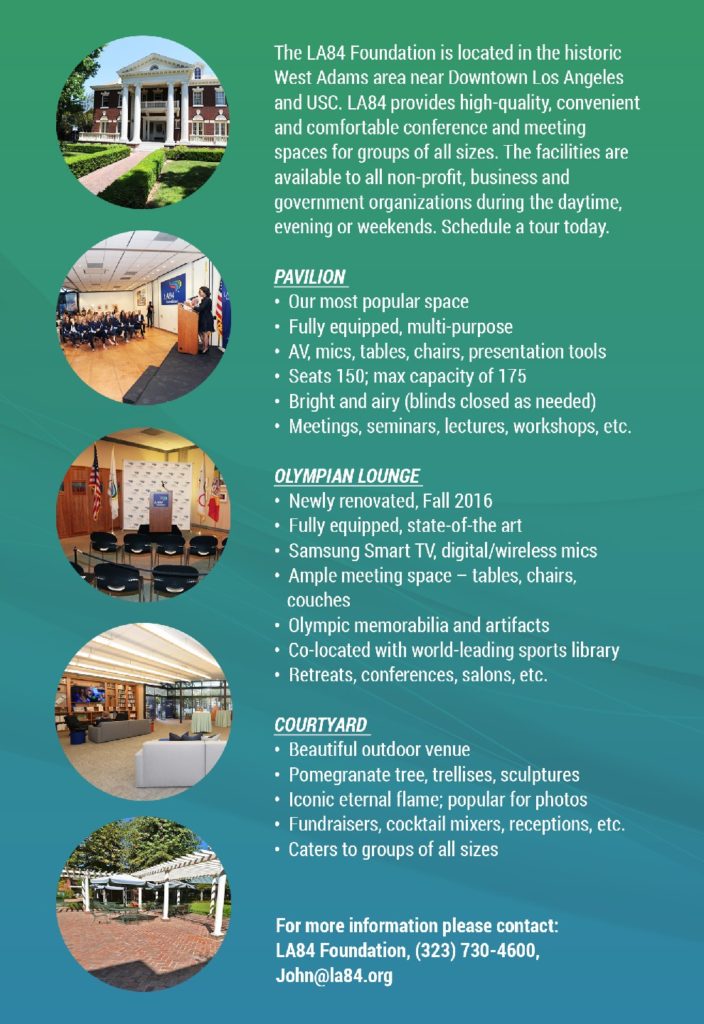SL Interview: Filmmaker Fred Golding’s Wrestling Documentary “On the Mat”
In the state of Washington the wrestling program at Lake Stevens High School has developed into a storied powerhouse. The Vikings have won multiple state titles since Coach Brent Barnes, himself the son of a high school wrestling coach, took over the program in the late 1980s, including an 18-year undefeated skein in conference matches.
During the 2010-11 season, documentary filmmaker Fred Golding followed Barnes and the team as Lake Stevens pursued yet another state title. “On the Mat” focuses on Barnes’ efforts to mold his youngsters into winners and shows the sacrifices that the teenagers make during the season. Many starve themselves to “make weight,” while the sport’s physical demands are “somewhere in between torture and pure hell,” according to Chris Pratt, the film’s narrator and executive producer. Meanwhile, even as wrestling attracts more women grapplers, college scholarships remain a rarity.
New York City-based Golding has been writing, directing and producing documentaries for 25 years. He often partners with director-producer Mike Tollin on sports-related projects, including “Hardwood Dreams: Ten Years Later,” about the ill-fated Morningside High School (Inglewood, Calif.) basketball team that featured Stais Boseman; “Hank Aaron: Chasing the Dream,” which earned the pair an Academy Award nomination for Best Feature Documentary; “Bonds on Bonds,” ESPN’s reality show about Barry Bonds; and, most recently, “On the Mat.”
A truncated version of “On the Mat” originally appeared on MTV’s “True Life Presents” series in early 2012. The feature-length version of “On the Mat” just made its world premiere at the 2012 Tribeca/ESPN Sports Film Festival.
SportsLetter spoke to Golding by phone from New York City in early April, just before “On the Mat” debuted at the Tribeca Film Festival.
— David Davis
SportsLetter: How did you get involved in making a documentary about high-school wrestling?
Fred Golding: My longtime friend Mike Tollin was introduced to a guy by the name of Chris Pratt. Chris is an actor who’s well known for a recurring role on “Parks & Recreation.” He also was in the movie “Moneyball.” Chris went to Lake Stevens High School, and wrestled there. He had written a treatment about following a season with the wrestling team at Lake Stevens High School. That led to the initial TV sale of “On the Mat.”
SL: What was Chris Pratt’s role in the filming of the documentary?
FG: He was the narrator for the film and the executive producer. He wrestled with the kids, and we did a long interview with him. More importantly, with him we had an immediate “in” with Lake Stevens and with the coach, Brent Barnes.
SL: Did you wrestle in high school?
FG: No, I didn’t. I played a little basketball.
SL: What was it like to be around the wrestlers during the season?
FG: There’s no question in my mind that high school wrestling is the most demanding of any high school sport. There’s this inherent sacrifice that the kids make for the sport. To be great as a wrestler, you have to be as thin as your body will allow. If a kid normally walks around at 180 pounds, he might wrestle at 165 or even less. If a kid is normally 120 pounds, he might wrestle at 103 pounds. There’s all sorts of legal limits that high school athletic associations have for how much weight these kids can lose in comparison to their body fat, but every week they have to “cut weight” in order to compete.
What’s interesting about it is that kids in high school — in 10th or 11th or 12th grade — are still growing. They want to eat, and yet they have to lose weight. It becomes this constant give-and-take of how much they can not eat before they weigh in for the match. Wrestlers have to be ultra-discipline, unlike, say, a defensive back in football who can eat pretty much everything and anything. It’s a level of dedication that’s unparalleled.
SL: Did the wrestlers walk around thinking they were physically indestructible?
FG: I think that wrestling is a sport where you have to feel that you’re invincible, that you’re indestructible. You win or lose matches not based so much on physical ability. You win or lose matches based on mental toughness.
On the other hand, these were 15, 16, 17-year-old kids. They’re adolescents. So, there’s an inherent vulnerability to these kids, to being a high-school student. There’s an interesting mix that you see: on the one hand, they feel they’re indestructible, but on the other hand they still show their emotions. After Ryan Rodrigo loses in the state tourney, he completely breaks down. All of the emotions that he didn’t express on the mat come out off the mat.
SL: Did you find it difficult to film the wrestling action?
FG: Shooting the sport of wrestling was a challenge. I was very lucky in that Coach Barnes is at a point in his career where he really wants to spread the word about wrestling and how good of a sport it is for kids. He was extremely helpful in filming. He would advise me on the storylines and knew exactly what I wanted.
I still don’t understand the intricacies of the sport. I still don’t understand why a wrestler would do “x” move as opposed to “y.” But as Coach Barnes would say, it’s just like the Greeks used to do it: they drew a circle in the sand and two guys went out and wrestled within that circle. It’s still pretty much like that today.
SL: How would you describe Coach Barnes and his influence on the team?
FG: He teaches physical education and is a well-read, well-rounded person. And he’s an amazing coach. What he attempts to do is to educate these kids in the sport of wrestling. But he’s a firm, firm believer that wrestling teaches lessons that will prepare them for the bigger game of life. To use a metaphor that he uses: if you get pinned, on the mat or in your life, you have to get back up.
Coach Barnes and I would go back and forth: why wrestle? Why in the world would a high school kid want to wrestle? You can’t eat, you can’t do this or that during the season. One kid said to me, “It’s like a drug. You’re addicted.” And maybe that’s what these kids are: they’re addicted to that kind of physical activity, to that kind of physical endurance.
Wrestling is an anomaly compared to other high school sports. Wrestlers are extremely lucky to get a scholarship because not that many colleges have wrestling programs. It’s not like basketball, where there’s Division I, II and III. There is no professional wrestling after college and the Olympics – besides the “antic wrestling” that you see on TV. Their time on the mat is limited inherently. That’s why, to me, wrestling is a lot purer as a sport than basketball or football. The level of determination and sacrifice is far greater.
SL: What was it like to film the team for an entire season?
FG: The Lake Stevens wrestling team is really, really good. In the state of Washington, they’re practically undefeated. The kids sort of know that they’re going to win the in-state matches. But they were coming off a disappointing season and then, when they wrestled at a tourney in the Lehigh Valley in Pennsylvania — they got shut out, 58-0, by the number-one team in the country, Blair Academy, a private school in New Jersey. The kids questioned their ability after that.
But the kids were pretty resilient and rebounded. With wrestling, there’s what they call “the second season,” which is the district and the regional tournaments and then the state tournament. Once the second season starts, there’s a whole new level of intensity that these kids have. Ultimately, they ended up winning their eighth state championship.
SL: What was it like to film the kids? Do you have to approach them differently than Coach Barnes?
FG: What any documentary filmmaker has to deal with nowadays is what I call the “reality TV syndrome.” That is, everyone knows about reality TV because it’s on 24 hours a day. However, once the cameras were around for a period of time, once these kids realized that we weren’t going away, they began to act natural. It probably took two-to-three weeks to where they began to give you answers to questions that were more than just sports clichés. As in, “That opponent was really tough.” As opposed to, “I felt horrible going into this match and just worked my ass off.” Real responses.
As a filmmaker, I do character-driven stories. I really get involved with a person’s life. For me, it’s a juggling act between finding your star athletes and finding the athletes who are interesting characters. I got lucky in that the five athletes that I followed at Lake Stevens were really interesting. And, I couldn’t have written the final chapter of the story: Steven [Waikley], the kid who’s academically troubled, who’s the outcast on the team even though he’s a superstar talent, wins the match that wins the state championship for the team.
SL: Were you rooting for them to win?
FG: It’s hard not to get influenced and affected by the kids you’re following. A lot of people were rooting for this one kid, Ryan Rodrigo, to win at state. Ryan was the one who pushed himself to the nth degree, who worked harder than anyone else, and as a senior had never won a state title. And that’s all he dreamed of. His dreams did not become reality. He finished third. I think a lot of people would have liked to see him win the championship for Lake Stevens.
SL: You showed sensitive material in the film, particularly about Steven’s poor grades and him getting into a fight. Did you have qualms about showing that?
FG: The fight happened, I think, because Steven was under a lot of pressure. He didn’t “cut weight” to help the team for that one match, and frankly he blew up. He didn’t notice the camera around. We got lucky.
SL: What most surprised you during the filming?
FG: What surprised me was how incredibly tough the wrestlers are. One of the kids, Eric Soler, tore his ACL at a tournament in Pennsylvania. Most people wouldn’t think of wrestling the rest of the season. He put on a knee brace and wrestled into the state tournament. He finished fourth — unheard of. A week after the state tournament, he underwent major knee surgery. They repaired his ACL, and he won the 2012 state tournament at 126 pounds as a junior. He’ll be back next year as a senior.
I really learned something about the kids and their endurance, their level of sacrifice, their level of determination, which I believe is far different than any other high school sport. It is that difficult. These guys are in that great a shape. They do treat their bodies differently than any athlete I’ve ever seen.
SL: Did Lake Stevens have any girl wrestlers on the team?
FG: There were a couple of girls on the team. But they didn’t make much of a splash – they didn’t advance to the district and/or regional finals.
SL: “On the Mat” aired first on MTV, and then you expanded it into a feature-length documentary. What are the differences between the two versions?
FG: They’re completely different. The long version has Chris [Pratt] on camera, uses Chris as the narrator, and has a lot more with Coach Barnes in there. For MTV, where the primary demographic is more like 17-to-25, I pulled out all of material with Chris Pratt and most of the coach. It’s much shorter and geared toward a younger audience.
SL: There’ve been a lot of recent documentaries about youth sports, including “Undefeated,” the most recent Academy Award winner. Why do you think there’s such interest in the subject?
FG: There’s not many areas in society that haven’t been explored by a camera. High school and high school sports is an area that is still open to treatment by a documentarian. The difficulty is getting approvals: it’s not just an individual high school, it’s the district that also has to approve it. You have to get the opposing teams to give their approval. We were lucky because Lake Stevens was very welcoming to us and Coach Barnes was extremely welcoming to us. We were not kicked out of any meetings. And, ultimately, the camera became pretty invisible to these kids.
Sports, as a metaphor, is so great because you’re always going to have winning and losing. You naturally have a dramatic arc. With wresting, there’s a bunch of dramatic arcs that you can have because there’s two seasons — the regular season and then the state finals.
SL: Are all these youth sports documentaries the offspring of “Hoop Dreams?”
FG: I think “Hoop Dreams” was a noble effort. The filmmakers had the determination to follow two kids for four years. That takes a lot. It’s one thing to follow kids over a season; it’s another to follow them for four years. No one’s ever going to finance that. So, they deserve all the accolades that they received.
Is every other high school sports documentary a derivative of “Hoop Dreams”? I would say no. I think that the world of sports, in particular, is a documentarian’s delight, just in terms of storytelling.
SL: Were you influenced by any particular sports documentary with “On the Mat”?
FG: Frankly, no. I’ve been doing this for a long time. I want to be influenced by my characters. In a sense, my characters are my actors – and that’s who I want to be influenced by. I’m much more interested in finding out who my characters are, how do I treat them, how do I get the material that I think I can get from these characters. You have to follow them and know when to turn on the camera and when to turn off the camera. Then, when you’re editing, you have to know what to pick and what to choose. That’s really where the gold is found.
SL: You’ve worked a lot with Mike Tollin — how would you describe your relationship?
FG: Mike and I grew up together in Haverford, Pa. We went to the same high school, we went to the same summer camp. He’s my “oldest living friend,” if you will. We not only have a good professional relationship, but we also have a very close personal relationship.
SL: What was it like to work with him on “On the Mat”?
FG: He was very much an objective producer — both he and Chris [Pratt] were. I really carved the story and made the film. But you have to drop the ego in the editing room. You bring in your executive producer and say, “What do you think?” Mike has a great storytelling sense. He has a gut for sports stories better than anyone that I know. He would say, “I think this would go better here.” Or, “Move the section about Steven’s academics a little bit later.” Or, “Break this section into two sections.” Usually, he was 100 percent right. He’s fabulous at that.
As a director, you need that. You need that objective observer because you’re so ensconced in the project, from shooting to now editing, that you need someone to look at it before it goes out to a network or to a film festival.
SL: Mike Tollin directed “Hardwood Dreams,” a documentary about the Morningside High School basketball team from Inglewood, and you directed the sequel, “Hardwood Dreams: Ten Years Later.” What struck you about revisiting the team ten years after their senior season in high school?
FG: It was a very difficult experience. What happened was, none of the players became a success in basketball after high school. Except for Stais Boseman, who had a pretty good collegiate career at USC, none of the kids ended up playing high-level college basketball. One kid got kicked off the team, one kid left the university, one kid later served time in prison. So, they were very jaded. This is not to criticize the kids, but none of them saw the money or the glory that they thought they were going to see when they were in high school. It never happened. Instead, they were back in Inglewood, trying to make a better life for themselves in a very difficult environment. It was tough because I think they felt, at times, that I was exploiting them. And I wasn’t. I was just trying to get the real story out.
I think it’s difficult, with any athlete, to show what happens when you give up athletics. That’s inclusive of someone like Joe Montana or someone like Stais Boseman. For Joe Montana, he’s lucky in that he made a lot of money and probably has a lot of endorsements and whatever else. For someone like Stais Boseman, who ended up back in the same environment that he came from, it’s a different story.
SL: Are you going to revisit the story? Will there be a “Hardwood Dreams: Twenty Years Later?”
FG: I’d like to, if the kids are willing. I mean, they’re not kids anymore – they’ll almost be 40 by the time we do “Hardwood Dreams III.” But I haven’t spoken to them in a while.
SL: Mike Tollin directed the documentary “Hank Aaron: Chasing the Dream,” and you produced it. What was that experience like?
FG: In a certain sense, “Chasing the Dream” was an homage to Hank. Hank is a great, great figure in baseball, but he’s also a great human being. He grew up in a small town in Alabama, and he was this understated, amazing athlete. Ultimately, what we tried to do with “Chasing the Dream” was to retain the spirit of integrity that you find in Hank Aaron.
SL: How did it feel to be nominated for an Academy Award?
FG: When you’re a documentary filmmaker, and you’re sitting in an audience with people who make $50 to $100 million movies, you feel a little bit like a fish out of water. But it was exciting. We worked our backsides off on “Hank Aaron.” And, certainly, being nominated for an Academy Award gave a certain level of recognition to me and to Mike.
SL: What’s next for you?
FG: We’ll see what happens with “On the Mat” after Tribeca. But I’ll probably decide on another long-form documentary, subject wise, in the next month or so. I’m grappling with a couple subjects right now. And then, through my own company [Golding Oditz Productions], I’m writing a fictional piece. I’m trying to branch out a little at this stage in my career. But if a good sports story comes along, I’ll do it again.




